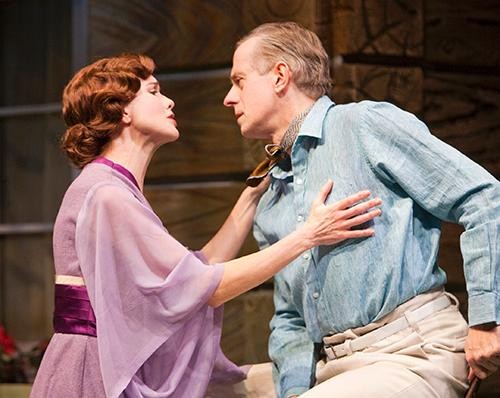The advantages that plays have over other art forms are, in theory, countless. The live aspect is supposed to give a sense of immediacy, the actors have the opportunity to better engage their audience and the crowd’s involvement can add to the experience, too. And in the Arizona Theatre Company’s production of Jeffrey Hatcher’s original play, “”Ten Chimneys,”” these truths are exactly the point.
Based on the legendary Broadway couple of Alfred Lunt and Lynn Fontanne and their 1930s production of Chekhov’s “”The Sea Gull,”” the play tracks a partial cast as they investigate the script they have chosen at the Lunts’ Wisconsin home. A work of speculation and invention, “”Ten Chimneys”” slowly builds a case for the inextricability of life and passionate art.
It is through the “”Inception””-style intertwining of the characters’ lives and their assumed roles in Chekhov’s Russian comedy, “”The Sea Gull,”” that the play delivers its message. But it is through the historical gossip column-feel (here’s the mostly fictional scoop on rich and famous Broadway loves of yore) and drama (borrowed from the traitorous lovers and lurking insanity in “”The Sea Gull””) that it maintains audience attention. Not that it always does.
The sign in the hallway stating the show’s length should look more like caution tape; at nearly two and a half hours, It wasn’t a surprise to hear spectators complain that the play dragged on.
Even the seemingly experienced cast — solid in their effort and execution, hilarious in their well-paced laugh-out-loud moments — wasn’t quite enough to make the complex, slow-motion storyline entirely digestible. The humor written into the play is of a snarky banter variety, which comes to a head in back and forths such as: “”Hattie’s a dream, isn’t she?”” “”Yes, the kind you tell to an analyst.”” From this, much like from inside jokes in sitcoms, the audience derives a sense of intimacy among themselves and the characters before them.
The play’s assumptions about the power of theater, which ultimately form the basis for its myriad emotions, betrayals and uncut drama, are ironically undercut by the production of the play itself. If the audience is supposed to come away with a better understanding of the inseparability of passionate acting and passionate living, shouldn’t the play itself be one so honest it seems lifelike?
Props to Arizona Theatre Company for diving headfirst into the world Hatcher created; from the honest play acting within play acting to the nuanced set — complete with a full-sized studio cabin and a tree canopy suggestive of dappled forest light — everything seems done sans stops.
But something is still amiss. As “”Ten Chimneys”” speaks to the draw and power of plays, the audience becomes ever more aware of the contrived nature of the play they’re in the middle of watching.









